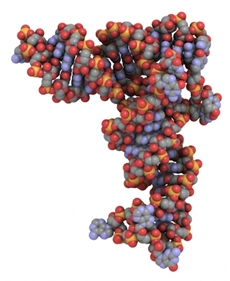New nanoparticles shrink tumours in mice
By By Anne Trafton, News Office | 17 Aug 2012
By sequencing cancer-cell genomes, scientists have discovered vast numbers of genes that are mutated, deleted or copied in cancer cells. This treasure trove is a boon for researchers seeking new drug targets, but it is nearly impossible to test them all in a timely fashion.
 |
| Short strands of RNA can be used to selectively turn off cancer genes. |
To help speed up the process, MIT researchers have developed RNA-delivering nanoparticles that allow for rapid screening of new drug targets in mice. In their first mouse study, done with researchers at Dana-Farber Cancer Institute and the Broad Institute, they showed that nanoparticles that target a protein known as ID4 can shrink ovarian tumors.
The nanoparticle system, described in the Aug. 15 online edition of Science Translational Medicine, could relieve a significant bottleneck in cancer-drug development, says Sangeeta Bhatia, the John and Dorothy Wilson Professor of Health Sciences and Technology and Electrical Engineering and Computer Science and a member of the David H Koch Institute for Integrative Cancer Research at MIT.
''What we did was try to set forth a pipeline where you start with all of the targets that are pouring out of genomics, and you sequentially filter them through a mouse model to figure out which ones are important. By doing that, you can prioritize the ones you want to target clinically using RNA interference, or develop drugs against,'' says Bhatia, one of the paper's senior authors.
William Hahn, an associate professor of medicine at Harvard Medical School and the paper's other senior author, is the leader of Project Achilles, a collaborative effort to identify promising new targets for cancer drugs from the flood of data coming from the National Cancer Institute's cancer-genome-sequencing project.
Among those potential targets are many considered to be ''undruggable,'' meaning that the proteins don't have any pockets where a traditional drug could bind to them. The new nanoparticles, which deliver short strands of RNA that can shut off a particular gene, may help scientists go after those undruggable proteins.






























